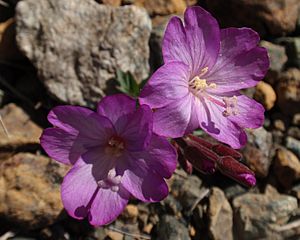Siskiyou willowherb facts for kids
Quick facts for kids Siskiyou willowherb |
|
|---|---|
 |
|
| Scientific classification | |
| Genus: |
Epilobium
|
| Species: |
siskiyouense
|
The Siskiyou willowherb (scientific name: Epilobium siskiyouense) is a special kind of flowering plant. It belongs to the evening primrose family. People also call it the Siskiyou fireweed, even though it's not a "true" fireweed. This plant is quite rare, meaning it's not found in many places.
Where Does the Siskiyou Willowherb Grow?
This unique plant lives only in a specific area called the Klamath Mountains. You can find these mountains in far northern California and southern Oregon. This means the plant is "endemic" to this region, which means it naturally grows nowhere else in the world!
The Siskiyou willowherb likes to grow in mountain areas. It often lives in rocky slopes called "talus" in high alpine zones. It also grows in subalpine coniferous forests. These are forests with cone-bearing trees, found just below the treeline. Sometimes, it even grows in special serpentine soils, which are rich in certain minerals.
What Does the Siskiyou Willowherb Look Like?
The Siskiyou willowherb is a small plant that grows in clumps. It's a "subshrub," which means it's partly woody and partly soft. It grows from a woody base called a "caudex." The plant can reach a height of about 25 centimeters (about 10 inches).
Its stems are often covered with tiny scales and can be quite hairy. They might also feel a bit sticky because they have glands. The leaves are shaped like a spear or an oval and are usually less than 3 centimeters (about 1 inch) long.
Siskiyou Willowherb Flowers
The flowers of the Siskiyou willowherb grow in a cluster called an inflorescence. These flower clusters are also glandular, making them feel a bit sticky. The flowers are a beautiful bright to deep pink color. Each petal is about 1 or 2 centimeters long.
After the flowers bloom, they produce a fruit. This fruit is a hairy capsule, which is like a small pod. It can grow up to 4.5 centimeters (about 1.7 inches) in length. Inside this capsule are the plant's seeds.

